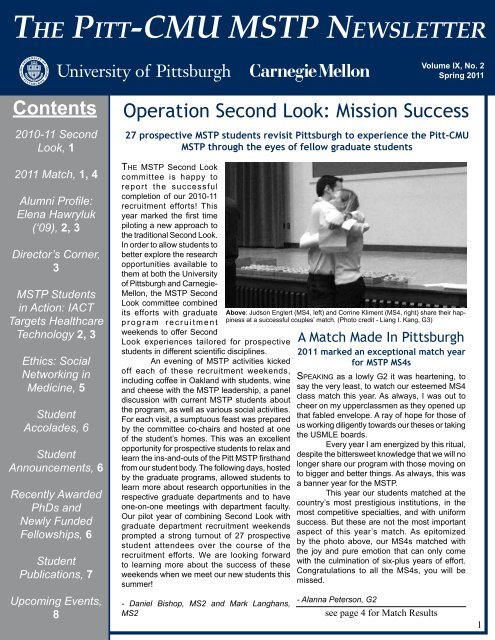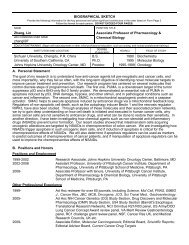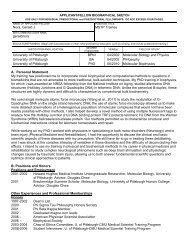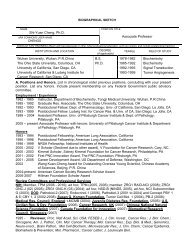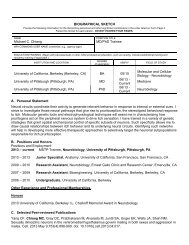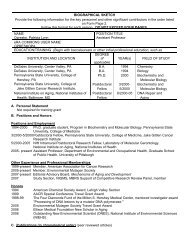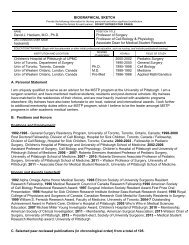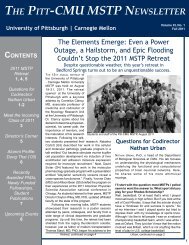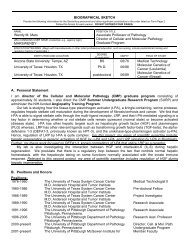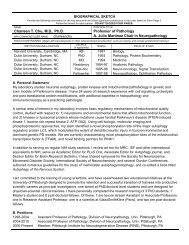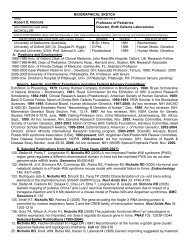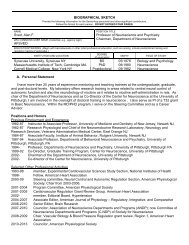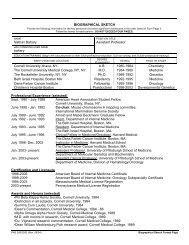The PiTT-CMU MSTP NewSleTTer - University of Pittsburgh :: MSTP
The PiTT-CMU MSTP NewSleTTer - University of Pittsburgh :: MSTP
The PiTT-CMU MSTP NewSleTTer - University of Pittsburgh :: MSTP
Create successful ePaper yourself
Turn your PDF publications into a flip-book with our unique Google optimized e-Paper software.
<strong>The</strong> Pitt-<strong>CMU</strong> <strong>MSTP</strong> Newsletter<br />
Volume IX, No. 2<br />
Spring 2011<br />
Contents<br />
2010-11 Second<br />
Look, 1<br />
2011 Match, 1, 4<br />
Alumni Pr<strong>of</strong>ile:<br />
Elena Hawryluk<br />
(‘09), 2, 3<br />
Director’s Corner,<br />
3<br />
<strong>MSTP</strong> Students<br />
in Action: IACT<br />
Targets Healthcare<br />
Technology 2, 3<br />
Ethics: Social<br />
Networking in<br />
Medicine, 5<br />
Student<br />
Accolades, 6<br />
Student<br />
Announcements, 6<br />
Recently Awarded<br />
PhDs and<br />
Newly Funded<br />
Fellowships, 6<br />
Student<br />
Publications, 7<br />
Operation Second Look: Mission Success<br />
27 prospective <strong>MSTP</strong> students revisit <strong>Pittsburgh</strong> to experience the Pitt-<strong>CMU</strong><br />
<strong>MSTP</strong> through the eyes <strong>of</strong> fellow graduate students<br />
<strong>The</strong> <strong>MSTP</strong> Second Look<br />
committee is happy to<br />
report the successful<br />
completion <strong>of</strong> our 2010-11<br />
recruitment efforts! This<br />
year marked the first time<br />
piloting a new approach to<br />
the traditional Second Look.<br />
In order to allow students to<br />
better explore the research<br />
opportunities available to<br />
them at both the <strong>University</strong><br />
<strong>of</strong> <strong>Pittsburgh</strong> and Carnegie-<br />
Mellon, the <strong>MSTP</strong> Second<br />
Look committee combined<br />
its efforts with graduate<br />
program recruitment<br />
weekends to <strong>of</strong>fer Second<br />
Look experiences tailored for prospective<br />
students in different scientific disciplines.<br />
An evening <strong>of</strong> <strong>MSTP</strong> activities kicked<br />
<strong>of</strong>f each <strong>of</strong> these recruitment weekends,<br />
including c<strong>of</strong>fee in Oakland with students, wine<br />
and cheese with the <strong>MSTP</strong> leadership, a panel<br />
discussion with current <strong>MSTP</strong> students about<br />
the program, as well as various social activities.<br />
For each visit, a sumptuous feast was prepared<br />
by the committee co-chairs and hosted at one<br />
<strong>of</strong> the student’s homes. This was an excellent<br />
opportunity for prospective students to relax and<br />
learn the ins-and-outs <strong>of</strong> the Pitt <strong>MSTP</strong> firsthand<br />
from our student body. <strong>The</strong> following days, hosted<br />
by the graduate programs, allowed students to<br />
learn more about research opportunities in the<br />
respective graduate departments and to have<br />
one-on-one meetings with department faculty.<br />
Our pilot year <strong>of</strong> combining Second Look with<br />
graduate department recruitment weekends<br />
prompted a strong turnout <strong>of</strong> 27 prospective<br />
student attendees over the course <strong>of</strong> the<br />
recruitment efforts. We are looking forward<br />
to learning more about the success <strong>of</strong> these<br />
weekends when we meet our new students this<br />
summer!<br />
Above: Judson Englert (MS4, left) and Corrine Kliment (MS4, right) share their happiness<br />
at a successful couples’ match. (Photo credit - Liang I. Kang, G3)<br />
A Match Made In <strong>Pittsburgh</strong><br />
2011 marked an exceptional match year<br />
for <strong>MSTP</strong> MS4s<br />
Speaking as a lowly G2 it was heartening, to<br />
say the very least, to watch our esteemed MS4<br />
class match this year. As always, I was out to<br />
cheer on my upperclassmen as they opened up<br />
that fabled envelope. A ray <strong>of</strong> hope for those <strong>of</strong><br />
us working diligently towards our theses or taking<br />
the USMLE boards.<br />
Every year I am energized by this ritual,<br />
despite the bittersweet knowledge that we will no<br />
longer share our program with those moving on<br />
to bigger and better things. As always, this was<br />
a banner year for the <strong>MSTP</strong>.<br />
This year our students matched at the<br />
country’s most prestigious institutions, in the<br />
most competitive specialties, and with uniform<br />
success. But these are not the most important<br />
aspect <strong>of</strong> this year’s match. As epitomized<br />
by the photo above, our MS4s matched with<br />
the joy and pure emotion that can only come<br />
with the culmination <strong>of</strong> six-plus years <strong>of</strong> effort.<br />
Congratulations to all the MS4s, you will be<br />
missed.<br />
Upcoming Events,<br />
8<br />
- Daniel Bishop, MS2 and Mark Langhans,<br />
MS2<br />
- Alanna Peterson, G2<br />
see page 4 for Match Results<br />
1
2<br />
Pr<strong>of</strong>iles in Medicine: Dr. Elena Hawryluk<br />
An alumna from the Class <strong>of</strong> 2009 advises future students on selecting a mentor, choosing a<br />
clinical specialty, and finding a balance between research and clinic in dermatology<br />
D r . Elena Hawryluk is a<br />
2009 Pitt <strong>MSTP</strong> alumna. She<br />
is currently a resident in the<br />
Harvard Dermatology Residency<br />
Program in Boston, Mass.<br />
Below, she reflects on her Pitt<br />
experience, talks about her<br />
current position, and shares<br />
advice for future Pitt-<strong>CMU</strong> <strong>MSTP</strong><br />
graduates.<br />
Q: How did you decide on a career<br />
as an MD/PhD<br />
A: I became interested in the MD/<br />
PhD career through the mentorship<br />
and advice <strong>of</strong> several researchers<br />
I was fortunate to work with during<br />
college. I studied computer<br />
science and was involved in<br />
research projects at the interface<br />
<strong>of</strong> technology and medicine, such<br />
as a robotic-assisted surgery<br />
project at Carnegie Mellon, and a<br />
spectral imaging analysis project<br />
that involved pathology samples.<br />
I worked for mentors that gave me<br />
exposure to clinical medicine and<br />
the exciting prospect <strong>of</strong> combining<br />
research and clinical activities.<br />
Q: How did you pick your thesis lab<br />
and mentor<br />
A: First, I decided that I wanted a<br />
strong basic science foundation<br />
during graduate school, regardless<br />
<strong>of</strong> scientific subject. I spoke<br />
with many different people, from<br />
graduate students to department<br />
chairs, and even Dr. Levine, to<br />
hear their perspectives on good<br />
mentors and laboratories that<br />
would help me accomplish my<br />
goals. I did three rotations, each<br />
in a different department, which<br />
gave me excellent exposure to<br />
different areas and techniques,<br />
before joining Dr. Apodaca’s lab<br />
in cell biology. I had a wonderful<br />
experience in Dr. Apodaca’s<br />
laboratory—he is an outstanding<br />
mentor!<br />
Q: How did you choose your<br />
specialty<br />
A: Selecting a medical specialty<br />
was difficult because I enjoyed<br />
all <strong>of</strong> my clinical experiences.<br />
I chose my specialty while in<br />
graduate school and found the<br />
LCC to be pivotal in helping me to<br />
determine my path. I had a great<br />
longitudinal clerkship experience in<br />
otology, and then was exposed to<br />
dermatology, which I found to be a<br />
perfect fit for me.<br />
Q: Please tell me a little bit about<br />
what your day is like now.<br />
A: We have a daily didactic in the<br />
morning, followed by outpatient<br />
clinics or consults, depending<br />
on the rotation. I have protected<br />
elective time to explore many<br />
see page 3, Hawryluk<br />
Watch Out Bill Gates, Here Comes the IACT<br />
Students from the <strong>MSTP</strong> along with <strong>University</strong> <strong>of</strong> <strong>Pittsburgh</strong>, Carnegie Mellon and Duquesne<br />
graduate students spur a grassroots innovation movement to improve healthcare technology<br />
Where do students in business,<br />
medicine, science, and engineering<br />
sit down with <strong>Pittsburgh</strong>’s most<br />
talented and experienced industry<br />
pr<strong>of</strong>essionals to develop innovative<br />
healthcare solutions<br />
<strong>The</strong>y do so at IACT—<br />
Industry Academics Clinicians<br />
Together—an organization led by<br />
Pitt and <strong>CMU</strong> graduate students<br />
whose mission is to spur technology<br />
innovation within healthcare and<br />
improve the region’s economy.<br />
C<strong>of</strong>ounders include three <strong>of</strong> our<br />
own <strong>MSTP</strong> students, Daniel Bishop<br />
(MS2), Jim Fisher (MS2), and<br />
Jason Sanders (G1), and other<br />
students from Pitt, <strong>CMU</strong>, and<br />
Duquesne <strong>University</strong>.<br />
IACT was formed in July <strong>of</strong><br />
2010 and since then has engaged<br />
over 120 students and pr<strong>of</strong>essionals<br />
in workshops and competitions. It<br />
has received financial support<br />
and hosted speakers from many<br />
university-affiliated centers and<br />
local business accelerators. Thus<br />
far, IACT events have focused<br />
on two topics that reflect the<br />
strengths <strong>of</strong> the local academic and<br />
business communities, “Healthcare<br />
Technologies for an Aging America”<br />
and “Surgical Technology.”<br />
IACT was formed first with<br />
the knowledge that individuals<br />
in general, and students in<br />
particular, tend to stay within their<br />
own thought circles and that this<br />
hinders progress. <strong>The</strong> theory<br />
behind IACT is akin to that behind<br />
the <strong>MSTP</strong>—that multidisciplinary<br />
training hastens translation.<br />
Subsequently, events<br />
are specifically structured to mix<br />
students and pr<strong>of</strong>essionals from<br />
different backgrounds, effectively<br />
forcing them out <strong>of</strong> their comfort<br />
zone to solve a large problem in<br />
healthcare using technology. For<br />
example, at an event a medical<br />
student from Pitt may be partnered<br />
with a computer science student<br />
from <strong>CMU</strong>, an MBA student at<br />
Pitt, the CEO <strong>of</strong> a local biotech<br />
company, and a geriatrician at<br />
UPMC, and all are charged with<br />
creating a technology-based<br />
see page 3, IACT
In the past I have used this venue to<br />
highlight developments in the <strong>Pittsburgh</strong><br />
<strong>MSTP</strong>, but the past couple years <strong>of</strong><br />
economic changes push me to address<br />
more global issues related to physician<br />
scientist training. <strong>The</strong> various economic<br />
bubbles (beginning with the dot-com<br />
bubble and continuing with the housing<br />
bubble) have burst. In conjunction<br />
with tremendously expensive military<br />
ventures and a severe decline in our<br />
economy, these economic changes<br />
have shaken our country. We should<br />
have done the numbers in 2009 and<br />
better anticipated the implications <strong>of</strong><br />
these changes for research, but most<br />
<strong>of</strong> us buried our collective heads in the<br />
sand and hoped the economy would<br />
turn around before the implications <strong>of</strong><br />
our financial woes would be evident in<br />
research budgets.<br />
Well, despite a large stimulus<br />
package, the economy remains sluggish<br />
and tax revenues are down. Severe<br />
cuts are being made and pain that was<br />
especially pronounced in the private<br />
sector in 2009 has reached publicly<br />
funded research. NIH is proving to<br />
be one <strong>of</strong> the biggest casualties. This<br />
deep in the financial hole it is difficult<br />
to imagine a rosy horizon in the near<br />
future. It may be longer than a decade<br />
before discretionary funding recovers to<br />
a point where NIH funded research will<br />
have the leverage it has enjoyed in the<br />
recent past.<br />
What does this mean for training<br />
physician scientists I think the bottom<br />
line is that competition is<br />
going to be more than fierce.<br />
To be successful, freshly<br />
minted MD/PhDs are not<br />
going to prosper with just<br />
good science and clinical<br />
skills, but will also need a set<br />
<strong>of</strong> well-honed survival skills. Granting<br />
from NIH will still be important; however,<br />
broader horizons must be sought.<br />
Alternative sources <strong>of</strong> funding and<br />
focused collaborations may make the<br />
difference between viable careers and<br />
frustrating reassignment.<br />
Historically, much <strong>of</strong> <strong>Pittsburgh</strong>’s<br />
<strong>MSTP</strong> pr<strong>of</strong>essional development has<br />
been focused on the NIH. While skills<br />
learned in writing NIH grants have broad<br />
applicability, we are clearly charged<br />
with having to expand the training to<br />
Director’s Corner<br />
A Message From Clayton Wiley, MD, PhD<br />
Associate Dean, Director <strong>of</strong> <strong>MSTP</strong><br />
encompass new funding and research<br />
modes. <strong>The</strong> good news is that in the past<br />
12 years, we are committed to creating<br />
a real training program that is robust<br />
and adaptable, a great foundation for<br />
tweaking and creating a training engine<br />
to prepare for the new world. We plan<br />
to face the upcoming challenges for<br />
physician scientists head-on by not just<br />
preparing students for these challenges<br />
through training, but hopefully teaching<br />
them to anticipate frustrations and think<br />
outside the box to find solutions.<br />
from page 2, Hawryluk<br />
research opportunities as well<br />
as longitudinal academic time to<br />
pursue these interests during the<br />
year.<br />
Q: How do you currently balance<br />
family time and career, or how do<br />
you see yourself balancing these<br />
in the future<br />
A: I am fortunate to be in a field<br />
like dermatology which will allow<br />
me to have a focused outpatient<br />
clinic and very modular time to<br />
explore my academic and research<br />
interests, in addition to my career<br />
and family time.<br />
Q: Where do you see yourself in<br />
10 years<br />
A: In an academic center, with clinical<br />
and research responsibilities.<br />
Q: Do you have any advice for<br />
<strong>MSTP</strong> students<br />
A: Explore your options before<br />
making decisions, I am very happy<br />
to have gathered advice and<br />
learned from the senior <strong>MSTP</strong><br />
students before joining a lab.<br />
<strong>The</strong>se same senior <strong>MSTP</strong> trainees<br />
continue to be friends and mentors<br />
to me.<br />
- Niyathi Hegde, G1<br />
Dr. Elena Hawryluk can be reached at<br />
elena.hawryluk@gmail.com<br />
from page 2, IACT<br />
innovation to improve the wellbeing<br />
<strong>of</strong> older adults.<br />
IACT was also created to<br />
enable students to pursue ventures<br />
that otherwise might not find<br />
support. Whether a student at Pitt<br />
or <strong>CMU</strong>, in medicine or electrical<br />
engineering or management,<br />
it is <strong>of</strong>ten difficult to capitalize<br />
on an idea because the world<br />
looks at you as “just a student.”<br />
Nonetheless, individual students or<br />
teams <strong>of</strong> students have produced<br />
groundbreaking ideas worth<br />
supporting.<br />
IACT serves as a meeting<br />
place for students working in<br />
this vein so they can collectively<br />
support each other. Importantly, it<br />
also links these students to funding<br />
and consulting services in the<br />
region so students can build their<br />
ventures in the real world.<br />
<strong>The</strong> founders <strong>of</strong> IACT have<br />
a vision to make <strong>Pittsburgh</strong> a<br />
nationally-recognized force in<br />
healthcare innovation, and make<br />
students a part <strong>of</strong> that force.<br />
We invite you to learn more<br />
about IACT, including upcoming<br />
events, at www.iactpgh.com.<br />
- Daniel Bishop, MS2 and Jason<br />
Sanders, G1<br />
3
Match Day Results<br />
Congratulations To Our Soon To Be Doctor-Doctors!<br />
Mandar Aras — Internal Medicine, Duke <strong>University</strong><br />
Mehret Birru — Internal Medicine/Womens Health, <strong>University</strong> <strong>of</strong> <strong>Pittsburgh</strong><br />
Frank Cackowski — Internal Medicine, <strong>University</strong> <strong>of</strong> Michigan<br />
Sherrie Divito — Dermatology, Harvard <strong>University</strong><br />
Judson Englert — Internal Medicine, Harvard <strong>University</strong><br />
Corrine Kliment — Internal Medicine, Harvard <strong>University</strong><br />
Cyrus Raji — Radiology-Diagnostic, UCLA<br />
Melanie Ruffner — Pediatrics, Children’s Hospital <strong>of</strong> Philadelphia<br />
Jeremy Tilstra — Internal Medicine, <strong>University</strong> <strong>of</strong> <strong>Pittsburgh</strong><br />
Peter Vosler — Otolaryngology, <strong>University</strong> <strong>of</strong> <strong>Pittsburgh</strong><br />
Genevieve Woodard — Radiology-Diagnostic, UCSF<br />
Right: Sherrie Divito (MS4) opens her<br />
match letter to Harvard <strong>University</strong>. Bottom<br />
Left: Mehret Birru (MS4) announces her<br />
match to the <strong>University</strong> <strong>of</strong> <strong>Pittsburgh</strong>. Bottom<br />
Right: Mandar Aras (MS4) announces<br />
his match to Duke <strong>University</strong>. (Photo credits<br />
- Liang I. Kang, G3)<br />
4
Spotlight on Current Ethical Dilemmas:<br />
What Role, If Any, Does Social Networking<br />
plAy in Modern Medicine<br />
Technological advancements are happening at an amazing<br />
speed in our generation, enabling social networking sites to<br />
become increasingly accessible. Have you seen the Best Buy<br />
commercial with Ozzy Osbourne and Justin Bieber boasting<br />
about mobile internet speed upgrades Are you waiting with<br />
baited breath for the iPad 2 Were you behaving like a kid in<br />
a candy store when the iPhone 4 became available on the Verizon<br />
network I have to confess that I personally think “two<br />
networks are better than one.”<br />
At the end <strong>of</strong> last year, 31 percent <strong>of</strong> Americans owned<br />
smart phones and over four billion iPads were sold (Google.<br />
com). Whether it be via a smartphone, tablet, or notebook<br />
computer, the average medical student has internet access 24<br />
hours a day, seven days a week. You can video chat, tweet,<br />
update Facebook statuses, share pictures, and blog to your<br />
hearts content. What is more, network providers like T-Mobile ©<br />
and AT&T TM <strong>of</strong>ten advertise access to social networking sites<br />
as a feature <strong>of</strong> their devices. Awesome… right<br />
Example from one <strong>of</strong><br />
my Facebook friends:<br />
…. This lady came to<br />
ER because she saw<br />
raccoons in her garbage<br />
this morning and<br />
she feels “a little <strong>of</strong>f”<br />
so she would like to be<br />
checked for rabies<br />
-PHYSICIAN at Wesley<br />
Medical Center, CONN<br />
9 a.m. EST on Jan. 23<br />
via iPhone<br />
Neither <strong>of</strong> the posts contain common patient identifiers<br />
(see below), but the postings themselves leave date,<br />
time, and location information. Moreover, the comments<br />
that follow such posts can be explicit and mean.<br />
Maybe not.<br />
In spite <strong>of</strong> the fact that<br />
Facebook and MySpace<br />
activity can be used as evidence<br />
in a court <strong>of</strong> law, no<br />
one has stopped to ask if<br />
such accessibility to social<br />
networking is even necessary.<br />
Even though it gives<br />
me great delight to share<br />
that Charlie Sheen just set<br />
the “fastest time to reach 1 million followers” Guinness World<br />
Record this week (CNN Tech) after a string <strong>of</strong> purely comical<br />
tweets, many postings on Facebook are not laughing matters.<br />
Dr. Richard Steinman brought up the following submission<br />
from NY Times <strong>The</strong> Ethicist column:<br />
Some <strong>of</strong> my Facebook friends are medical students<br />
who post cellphone pictures <strong>of</strong> patients with what these friends<br />
believe to be comical maladies, with captions like “A 5-foot-9<br />
Hispanic male walks into a bar . . .” under a picture <strong>of</strong> a patient<br />
with a piece <strong>of</strong> rebar piercing his abdomen. <strong>The</strong> postings don’t<br />
include faces or names but still seem questionable. Doesn’t<br />
this violate patient privacy<br />
-NAME WITHHELD, NEW YORK<br />
Medical students getting into trouble on Facebook is<br />
not earth-shattering news. What is alarming is the frequency<br />
at which incidents like the one described above are occurring.<br />
In truth, it is not a rarity for medical students to post pictures <strong>of</strong><br />
themselves in the hospital with patients or to describe patients<br />
encountered on any given day.<br />
As a friendly reminder, the HIPAA Privacy Rule protects<br />
all individually identifiable health information held or<br />
transmitted by a covered entity or its business associate,<br />
in any form or media, whether electronic, paper, or oral.<br />
Identifiable health information<br />
includes demographic<br />
data and relates to:<br />
•the individual’s past,<br />
present, or future physical<br />
or mental health or condition<br />
•the provision <strong>of</strong> health<br />
care to the individual<br />
•the past, present, or future<br />
payment for the provision<br />
<strong>of</strong> health care to the<br />
individual, and that identifies<br />
the individual or for which there is a reasonable basis<br />
to believe can be used to identify the individual.<br />
policy.<br />
See www.hhs.gov/ocr/privacy/ for the complete<br />
Common patient identifiers include but are not limited<br />
to name, address, birth date, or Social Security Number.<br />
Questions to think about: Would it be reasonable to believe<br />
information accessible to 1,000 Facebook friends can be<br />
used to identify an individual And is it okay to share patient<br />
information as long as the patients are not identifiable With<br />
more than 500 million active Facebook users, half <strong>of</strong> which<br />
log on every single day, it might be wise to post with caution.<br />
- Natasha Corbitt, G2<br />
5
Student Accolades<br />
Congratulations to our newly funded Fellowship!<br />
Anoopum Gupta<br />
Cognitive Maps and Novel Behavioral Sequences in the Hippocampus (F30, Mentor: David Touretzky,<br />
PhD)<br />
Congratulations, Doctor! Recently Awarded PhDs<br />
Matthew Boyer<br />
DNMT3b’s role in hematopoietic stem cells. Advisor: Tao Cheng, MD (molecular genetics and<br />
developmental biology, Pitt)<br />
Michael Leibowitz<br />
Regulation <strong>of</strong> antigen processing machinery component expression in head and neck cancer by signal<br />
transducers and activators <strong>of</strong> transcription and SRC homology-2 domain-containing phosphotase.<br />
Advisor: Robert Ferris, MD, PhD (immunology, Pitt)<br />
Joseph Vella<br />
<strong>The</strong> role <strong>of</strong> stress resistance in cell transplantation efficacy for muscle regeneration. Advisor: Johnny<br />
Huard, PhD (bioengineering, Pitt)<br />
David Wheeler<br />
<strong>The</strong> PDZ adaptor, NHERF1, organizes and regulates protein complexes at the cell membrane. Advisor:<br />
Guillermo Romero, PhD (molecular pharmacology, Pitt)<br />
Student Announcements<br />
Judson M. Englert and<br />
Corrine R. Kliment<br />
will be wed on<br />
Saturday, April 9, 2011.<br />
Alanna C. Peterson and<br />
Erin E. Childs got engaged<br />
on Wednesday, March 9,<br />
2011.<br />
David S. Wheeler and<br />
Karen L. Condon<br />
got engaged on Saturday,<br />
March 19, 2011.<br />
All the Best To the<br />
Happy Couples!!!<br />
Brandon Alexander Tilstra<br />
(8 lb 7 oz) was born to Sarah<br />
and Jeremy Tilstra (MS4) on<br />
Friday, March 11, 2011.<br />
6
New <strong>MSTP</strong> Student Publications through March 2011<br />
Afrazi A, Sodhi CP, Richardson W, Neal M, Good M, Siggers<br />
R, Hackam DJ (2010). New Insights into the Pathogenesis<br />
and Treatment <strong>of</strong> Necrotizing Enterocolitis: Toll-like Receptors<br />
and Beyond. Pediatr Res. Dec 3. [Epub ahead <strong>of</strong> print;<br />
PMID: 21135755]<br />
Wells A, Chao Y, Grahovac J, Wu Q, Lauffenburger DA<br />
(2010). Cell motility in carcinoma metastasis as modulated<br />
by switching between epithelial and mesenchymal phenotypes.<br />
Frontiers in Biosciences (In press)<br />
Isse K, Grama K, Abbott IM, Lesniak A, Lunz JG, Lee WM,<br />
Specht S, Corbitt N, Mizuguchi Y, Roysam B, Demetris<br />
AJ (2010). Adding value to liver (and allograft) biopsy<br />
evaluation using a combination <strong>of</strong> multiplex quantum dot<br />
immunostaining, high resolution whole-slide digital imaging,<br />
and automated image analysis. Clin Liver Dis. 14(4):669-<br />
85. [PMID: 21055689]<br />
Glorioso C, Sibille E (2010). Between destiny and disease:<br />
genetics and molecular pathways <strong>of</strong> human central nervous<br />
system aging. Prog Neurobiol. Dec 1. [Epub ahead <strong>of</strong> print;<br />
PMID: 21130140].<br />
Johnson CA Jr, Wearden PD, Kocyildirim E, Maul TM, Woolley<br />
JR, Ye S-H, Strickler EM, Borovetz HS, Wagner WR.<br />
Platelet Activation in ovines undergoing sham surgery or<br />
implant <strong>of</strong> the second generation PediaFlow pediatric<br />
ventricular assist device. Artif Organs- (Accepted)<br />
Kang J, Steward RL, Kim YT, Schwartz RS, Leduc PR,<br />
Puskar KM (2011). Response <strong>of</strong> an actin filament network<br />
model under cyclic stretching through a coarse grained<br />
Monte Carlo approach. J <strong>The</strong>or Biol. Jan 15. [Epub ahead<br />
<strong>of</strong> print; PMID: 21241710]<br />
Kliment, CR, Oury, TD (2011). Extracellular superoxide dismutase<br />
protects cardiovascular syndecan-1 from oxidative<br />
shedding. Free Radic Biol Med. Feb 17 [Epub ahead <strong>of</strong><br />
print; PMID:213344435]<br />
Donthamsetty S, Bhave VS, Kliment C, Bowen WC, Mars<br />
WM, Bell AW, Stewart RE, Orr A, Wu C, Michalopoulos GK<br />
(2011). Excessive hepatomegaly <strong>of</strong> mice with hepatocytetargeted<br />
elimination <strong>of</strong> integrin linked kinase following treatment<br />
with 1,4-bis [2-(3,5-dichaloropyridyloxy)] benzene.<br />
Hepatology. Feb;53(2):587-95. [PMID: 21274879]<br />
Wang H, Nora GJ, Ghodke H, Opresko PL (2011). Single<br />
Molecule Studies <strong>of</strong> Physiologically Relevant Telomeric<br />
Tails Reveal POT1 Mechanism for Promoting Gquadruplex<br />
Unfolding. J Biol Chem. Mar 4; 286(9):7479-89. [PMID:<br />
21183684]<br />
Patel VP and Chu CT (2011). Nuclear transport, oxidative<br />
stress, and neurodegeneration. Int J Clin Exp Pathol. Mar;<br />
4(3):215-229.<br />
Pandiyan P, Conti HR, Zheng L, Peterson AC, Mathern DR,<br />
Hernández-Santos N, Edgerton M, Gaffen SL, Lenardo MJ<br />
(2011). CD4+CD25+Foxp3+ Regulatory T Cells Promote<br />
Th17 Cells In Vitro and Enhance Host Resistance in Mouse<br />
Candida albicans Th17 Cell Infection Model. Immunity. Mar<br />
25;34(3):422-434. [PMID:21435589]<br />
Du Y, Roh DS, Funderburgh ML, Mann MM, Marra KG,<br />
Rubin JP, Li X, Funderburgh JL (2010). Adipose-derived<br />
stem cells differentiate to keratocytes in vitro. Mol Vis. Dec<br />
10;16:2680-9. [PMID: 21179234]<br />
Sanders JL, Iannaccone A, Boudreau RM, Conley YP,<br />
Opresko PL, Hsueh W-C, Cummings SR, Cawthon RM,<br />
Harris TB, Nalls MA, Kritchevsky SB, Newman AB, for<br />
the Health ABC Study (2011). <strong>The</strong> association <strong>of</strong> cataract<br />
with leukocyte telomere length in older adults: defining a<br />
new marker <strong>of</strong> aging. J Gerontol A Biol Sci Med Sci. (Accepted)<br />
Prince CT, Secrest AM, Mackey RH, Arena VC, Kingsley<br />
LA, Orchard TJ (2011). Pulse wave analysis and prevalent<br />
cardiovascular disease in type 1 diabetes. Atherosclerosis.<br />
Dec; 213(2):469-74. [PMID: 20880527]<br />
McGuire ST, Secrest AM, Andrulonis R, Ferris LK (2010).<br />
Surveillance <strong>of</strong> patients for early detection <strong>of</strong> melanoma:<br />
Patterns in dermatologist vs. patient discovery. Arch Dermatol<br />
(Accepted)<br />
Secrest AM, Becker DJ, Kelsey SF, LaPorte RE, Orchard TJ<br />
(2011). Characterizing sudden death and dead-in-bed syndrome<br />
in type 1 diabetes: Analysis from 2 childhoodonset<br />
type 1 diabetes registries. Diabet Med. Mar; 28(3): 293-300.<br />
[PMID: 21309837]<br />
Secrest AM, Costacou T, Gutelius B, Miller RG, Songer TJ,<br />
Orchard TJ (2011). Association <strong>of</strong> socioeconomic status<br />
with mortality in type 1 diabetes: the <strong>Pittsburgh</strong> Epidemiology<br />
<strong>of</strong> Diabetes Complications (EDC) Study. Ann Epidemiol<br />
(Accepted)<br />
Shin SS, Bray ER, Zhang CQ, Dixon CE (2011). Traumatic<br />
brain injury reduces striatal tyrosine hydroxylase activity<br />
and potassium-evoked dopamine release in rats. Brain<br />
Res. Jan 19;1369:208-15. [PMID: 21047500]<br />
Sturman DA and Moghaddam B (2011). Reduced neuronal<br />
inhibition and coordination <strong>of</strong> adolescent prefrontal cortex<br />
during motivated behavior. J Neurosci Jan 26;31 (4):1471-<br />
1478. [PMID:21273431]<br />
Thompson MD, Awuah P, Singh S, Monga SP (2010).<br />
Disparate cellular basis <strong>of</strong> improved liver repair in betacatenin-overexpressing<br />
mice after long-term exposure to<br />
3,5-diethoxycarbonyl-1,4-dihydrocollidine. Am J Pathol.<br />
Oct;177(4):1812-22. [PMID: 20813968]<br />
Thompson MD, Dar MJ, Monga SP (2010). Pegylated interferon<br />
alpha targets Wnt signaling by inducing nuclear<br />
export <strong>of</strong> β-catenin. J Hepatol. Oct 29. [Epub ahead <strong>of</strong><br />
print; PMID: 21093092]<br />
Wilson ME, Boumaza I, Lacomis D, Bowser R (2010). Cystatin<br />
C: a candidate biomarker for amyotrophic lateral sclerosis.<br />
PLoS One. Dec 9;5 (12):e15133. [PMID: 21151566]<br />
Wong JL, Mailliard RB, Moschos SJ, Edington H, Lotze MT,<br />
Kirkwood JM, Kalinski P (2011). Helper activity <strong>of</strong> natural<br />
killer cells during the dendritic cell-mediated induction <strong>of</strong><br />
melanoma-specific cytotoxic T cells. J Immunother. 34:270-<br />
278. [PMID: 21389871]<br />
Woodard GA, Brooks MM, Barinas-Mitchell E, Mackey RH,<br />
Matthews KA, Sutton-Tyrrell K (2010). Lipids, menopause,<br />
and early atherosclerosis in Study <strong>of</strong> Women’s Health<br />
Across the Nation Heart women. Menopause. Nov 19.<br />
[Epub ahead <strong>of</strong> print; PMID: 21107300]<br />
7
<strong>University</strong> <strong>of</strong> <strong>Pittsburgh</strong>-Carnegie Mellon <strong>University</strong><br />
Medical Scientist Training Program<br />
526 Scaife Hall<br />
3550 Terrace Street<br />
<strong>Pittsburgh</strong>, PA 15261<br />
Upcoming Events<br />
April 2011<br />
30: Spring Term Ends<br />
May 2011<br />
2: Summer Term Begins<br />
17th: <strong>MSTP</strong> Workshop, 5 p.m. (<strong>University</strong> Club)<br />
23: Pitt SOM Graduation<br />
July 2011<br />
19: <strong>MSTP</strong> Workshop, 5 p.m. (S100A BST)<br />
August 2011<br />
8: Summer Term Ends<br />
19-22: <strong>MSTP</strong> Annual Retreat<br />
29: Fall Term Begins<br />
September 2011<br />
5: Labor Day (<strong>University</strong> Closed)<br />
<strong>The</strong> <strong>University</strong> <strong>of</strong> <strong>Pittsburgh</strong> and Carnegie<br />
Mellon <strong>University</strong>’s <strong>MSTP</strong> Newsletter<br />
Program Staff<br />
Director: Clayton Wiley, MD, PhD<br />
Codirectors: Richard Steinman, MD, PhD<br />
George Stetten, MD, PhD<br />
Administrative Director: Manjit Singh, PhD<br />
Program Manager: Justin Markuss<br />
Newsletter Staff<br />
Article and Layout Editor: Alanna Peterson (G2)<br />
Visit our website for more details about the<br />
program, including information about students<br />
and alumni:<br />
www.mdphd.pitt.edu<br />
Comments and submissions are encouraged!<br />
This newsletter is written and assembled by<br />
students <strong>of</strong> the <strong>MSTP</strong>. <strong>The</strong> views represented in<br />
this newsletter do not necessarily reflect those<br />
<strong>of</strong> the <strong>University</strong> <strong>of</strong> <strong>Pittsburgh</strong>, the <strong>University</strong><br />
<strong>of</strong> <strong>Pittsburgh</strong> School <strong>of</strong> Medicine, or Carnegie<br />
Mellon <strong>University</strong>.<br />
8<br />
77933-0511


